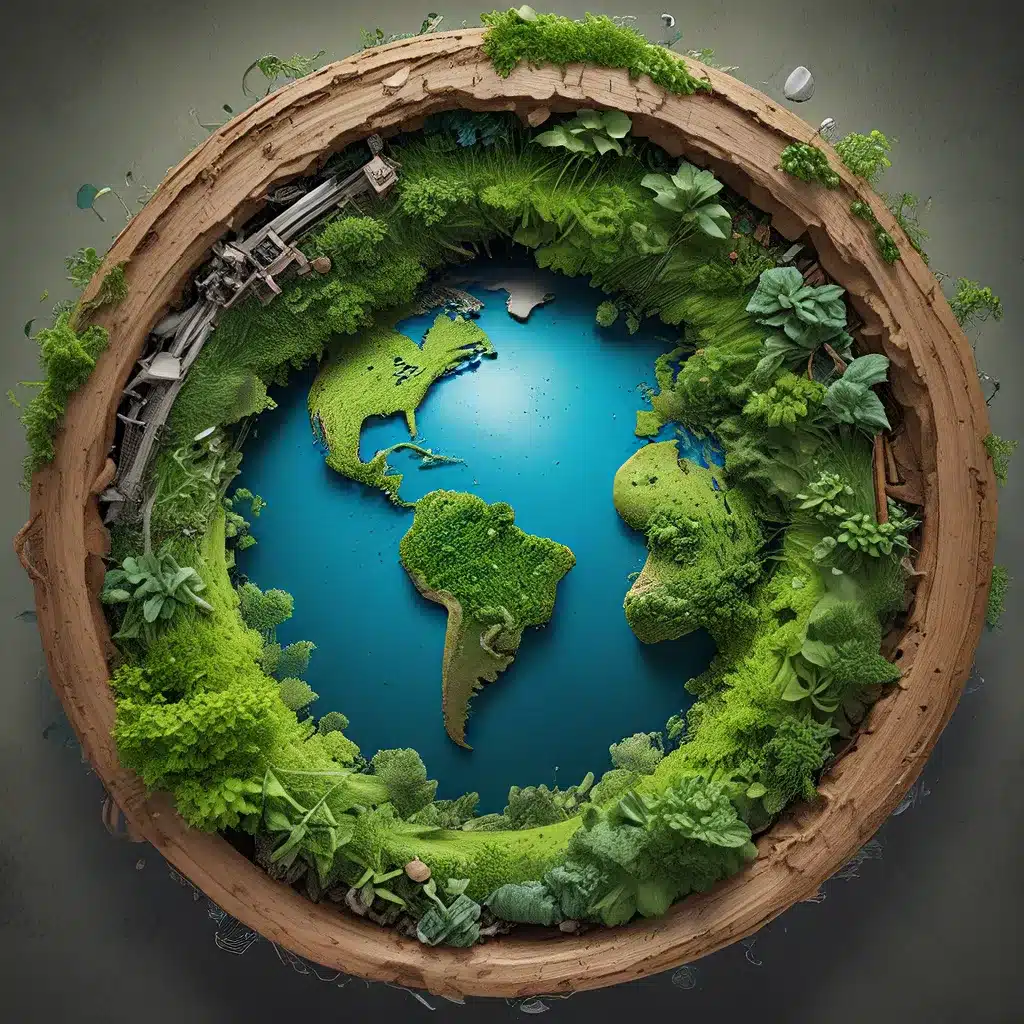
Embracing the Circular Economy: Innovative Approaches in Environmental Services
Rethinking Waste: The Promise of the Circular Economy
As I sit here, staring at the endless stream of information on my screen, one thing becomes increasingly clear – the world is in dire need of a radical shift in the way we think about waste and resource consumption. The traditional linear economy, where we extract, produce, and dispose, has served us well for decades. But its cracks are showing, and the environmental toll is becoming impossible to ignore.
Enter the circular economy – a transformative model that seeks to redefine our relationship with the resources we use. By emphasizing the efficient use and reuse of products, materials, and energy, the circular economy holds the promise of a more sustainable future. It’s a concept that has gained traction in recent years, with forward-thinking companies and organizations embracing its principles.
According to the World Economic Forum, the circular economy can unlock trillions of dollars in economic value and create millions of new jobs. But the real impact goes beyond the bottom line – it’s about preserving our planet for generations to come.
Pioneers of the Circular Shift
As I delve deeper into the topic, I’m inspired by the innovators leading the charge towards a more circular future. Take Patagonia, the outdoor clothing giant, for instance. They’ve been at the forefront of the circular economy movement since the 1980s, implementing initiatives like their Worn Wear program, which encourages customers to repair, reuse, and recycle their garments.
“By adopting sustainable materials, Patagonia is making strides to reduce the environmental impact of its products and promote a circular economy,” states Sustainability Magazine. It’s a testament to the power of a company that’s willing to challenge the status quo and prioritize sustainability over short-term profits.
Another trailblazer is IKEA, the Swedish home retail conglomerate. IKEA has made significant commitments to the circular economy, with initiatives like its take-back program, where customers can return their furniture to be repurposed or recycled. The company has also invested in sustainable materials, such as FSC-certified wood and recycled plastic, to reduce its environmental footprint.
“IKEA’s three main commitments – the take-back programme, circular services, and investing in sustainable materials – demonstrate its holistic approach to embracing the circular economy,” the article notes.
Tackling the Plastic Problem
One of the most pressing issues in the sustainability realm is the scourge of plastic pollution. Adidas, the sportswear giant, has taken a bold stance on this challenge through its “Three Loop Strategy.” The first loop involves recycling plastic waste, the second focuses on designing shoes that can be remade, and the third loop aims to use biodegradable materials that will disintegrate naturally.
As the World Economic Forum reports, “Adidas is a prime example of how a big business can change and take responsibility for its role in the plastic problem and pledge to use its influence to make a positive impact.”
It’s inspiring to see companies like Adidas, Patagonia, and IKEA stepping up to the plate and demonstrating that it’s possible to prioritize sustainability and still maintain a successful business model. Their efforts not only benefit the environment but also set a powerful example for others to follow.
Cultivating a Culture of Circularity
The transition to a circular economy is not just about individual company initiatives; it requires a collective shift in mindset and behavior. Unilever, the multinational consumer goods corporation, has recognized this and taken steps to advance its sustainability and circular economy goals.
Unilever has committed to using sustainable ingredients, such as ethically-sourced palm oil, to mitigate the environmental impact of its products. The company has also pledged to reduce packaging waste by 2025 and has established a recycling program to increase education and enhance recycling rates.
“Unilever has prioritised sustainability and circular economy goals by undertaking various measures to advance its objectives,” according to Sustainability Magazine. It’s a holistic approach that recognizes the importance of engaging consumers and fostering a culture of sustainability.
The Power of Collaboration
Embracing the circular economy is not a solo endeavor; it requires collaboration and partnerships across industries. Accenture, a global professional services company, has recognized this and has partnered with leading organizations like Mastercard, Amazon Web Services, Everledger, and Mercy Corps to advance its circular supply chain capability.
“The aim of this capability is to enhance financial inclusion, promote sustainable practices, and empower consumers,” the article states. By leveraging advanced technologies and forging strategic alliances, Accenture is helping its clients achieve their corporate sustainability goals through better resource planning and utilization.
The Future of the Circular Economy
As I continue to explore the exciting world of the circular economy, I’m struck by the sheer breadth of innovation and the potential for transformative change. From Inland Waters Inc.‘s cutting-edge water treatment solutions to the groundbreaking efforts of companies like HP, TrusTrace, and Mud Jeans, the future of the circular economy looks bright.
HP, for instance, has been incorporating circular practices into its operations for nearly two decades, collecting used ink cartridges and launching the world’s first monitor and an entire PC made from ocean-bound plastics. Meanwhile, TrusTrace is using its digital platform to bring transparency and traceability to the fashion industry, promoting best practices and raising awareness about individual responsibilities.
And then there’s Mud Jeans, a company that’s taking the circular economy to the next level by offering a leasing program for its recycled denim jeans. Customers can avoid the waste of buying new jeans they’ll rarely wear, contributing to a closed-material loop.
These are just a handful of the inspiring stories that are shaping the future of the circular economy. As we move forward, I can’t help but feel a sense of optimism and excitement. By embracing the principles of the circular economy, we have the power to transform our world, one sustainable solution at a time.


